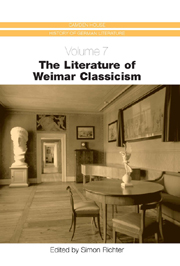Book contents
- Frontmatter
- Contents
- List of Illustrations
- Preface and Acknowledgments
- Conventions, Editions, and Abbreviations
- Introduction
- What is Classicism?
- Antiquity and Weimar Classicism
- The Correspondents' Noncorrespondence: Goethe, Schiller and the Briefwechsel
- Johann Gottfried Herder: The Weimar Classic Back of the (City)Church
- Drama and Theatrical Practice in Weimar Classicism
- German Classical Poetry
- The Novel in Weimar Classicism: Symbolic Form and Symbolic Pregnance
- German Women Writers and Classicism
- Weimar Classicism as Visual Culture
- The Irrelevance of Aesthetics and the De-Theorizing of the Self in “Classical” Weimar
- Goethe's “Classical” Science
- The Political Context of Weimar Classicism
- Bibliography
- Notes on the Contributors
- Index
German Classical Poetry
Published online by Cambridge University Press: 05 February 2013
- Frontmatter
- Contents
- List of Illustrations
- Preface and Acknowledgments
- Conventions, Editions, and Abbreviations
- Introduction
- What is Classicism?
- Antiquity and Weimar Classicism
- The Correspondents' Noncorrespondence: Goethe, Schiller and the Briefwechsel
- Johann Gottfried Herder: The Weimar Classic Back of the (City)Church
- Drama and Theatrical Practice in Weimar Classicism
- German Classical Poetry
- The Novel in Weimar Classicism: Symbolic Form and Symbolic Pregnance
- German Women Writers and Classicism
- Weimar Classicism as Visual Culture
- The Irrelevance of Aesthetics and the De-Theorizing of the Self in “Classical” Weimar
- Goethe's “Classical” Science
- The Political Context of Weimar Classicism
- Bibliography
- Notes on the Contributors
- Index
Summary
The concept of the “classical” is always retrospective in its attributions. This is the lesson conveyed by a remarkable special exhibition devoted to the artworks of ancient Greece, primarily sculpture, which was organized at the Martin-Gropius-Bau in Berlin during the spring of 2002. We have become accustomed, at least since the studies by Johann Joachim Winckelmann in the mid-eighteenth century, to regard the artworks of antiquity under the concept of the classical, above all with reference to the highpoint of this tradition in Athens during the fifth century b.c. The norm of the classical in art, whether in reference to sculptures by Phidias or Praxiteles, to such an architectural triumph as the Parthenon, or to the tragedies of Aeschylus and Sophocles, has served for centuries as an ideal against which all other artworks may be measured. This was as true for Goethe, the Schlegels, and Hegel as it had been for Winckelmann. Yet the artists, architects, or playwrights of the classical era in ancient Athens would not have regarded their work in any sense as “classical.” Such a normative value judgment was made only much later, in retrospect, as for instance in the Hellenistic era or in imperial Rome, when so many imitations of “classical” art were attempted, not to mention more distant views of the artworks of antiquity as developed in the Italian Renaissance or in German aesthetics following Winckelmann. The concept of the classical in art invariably defines a norm regarded as having been achieved in the past and unavoidably lost to the present.
- Type
- Chapter
- Information
- The Literature of Weimar Classicism , pp. 169 - 210Publisher: Boydell & BrewerPrint publication year: 2005



